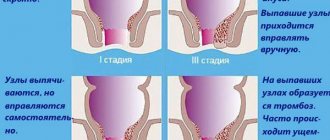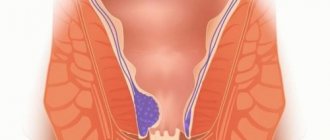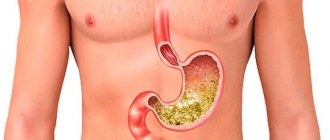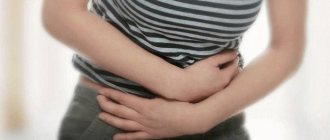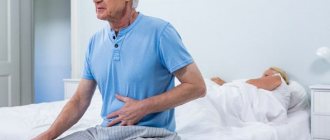An increasing number of modern doctors use traditional medicine methods in their practice. Thus, the therapeutic course aimed at treating hemorrhoids increasingly includes the use of unconventional methods.
Herbs are the basis of traditional medicine; it is on their basis that a large number of popular, effective recipes are prepared. “What herbs to drink for hemorrhoids?” is a common question that GPs often hear.
There is no definite answer, but by noting the main features of herbs, basic recipes, contraindications, you can understand which recipes are effective.
Characteristics of the disease
Hemorrhoids are a stagnant process of blood in the veins of the lower pelvic intestines.
Hemorrhoids are not only an unpleasant sensation, but also a high risk of complications, such as blood clots, iron deficiency anemia and strangulation of hemorrhoids. It is for this reason that if a problem occurs, you should immediately consult a doctor. The initial stage is easily curable. If the disease is neglected, it is unlikely that it will be possible to solve the problem without surgery.
At risk:
- people suffering from constipation;
- pregnant women;
- people who regularly carry weights and athletes;
- overweight people.
The development of the disease is divided into four stages:
- The initial stage is itching, blood during bowel movements and temporary enlargement of hemorrhoids. At this stage, symptoms are not constant. They can disappear for a long time and also appear suddenly.
- The symptoms of the first stage include prolapse of hemorrhoids and minor bleeding from the anus. Symptoms intensify with significant force loads.
- A new symptom is the loss of nodes, even with minor loads. They no longer fall into place on their own; they must be adjusted manually. Bleeding from the anus is more frequent and more voluminous than in the second stage. There is swelling of the anus and heaviness in that area.
- At this stage, prolapse of hemorrhoids occurs regularly and is practically not corrected manually. Severe anal bleeding leading to anemia. Constant pain and inflammation around the anus.
Hemorrhoids are classified by location:
- Internal - this form is characterized by bleeding due to varicose veins inside the anal canal. When stressed, the nodes fall out and can become deformed.
- External - this form usually goes away without bleeding. The nodes are located outside and are not damaged during defecation. There is a high risk of blood clots and inflammation of external hemorrhoids. This form of the disease is accompanied by constant itching, pain and discomfort. By palpating the anus area with a finger, seals are felt.
- Combined is the presence of two forms of the disease at the same time. External and internal hemorrhoids.
List of requirements for medicinal herbs for hemorrhoids
There are a huge number of different techniques, but not all are suitable for treating hemorrhoids. Before noting the main conditions that permit admission, it is necessary to understand what pathology is.
Hemorrhoids are a pathological process characterized by inflammation, protrusion of the walls of the rectum, and the formation of hemorrhoids. If left untreated, hemorrhoids can become chronic, so it is important to start therapy on time.
A herbal mixture for the treatment of hemorrhoids should have the following effects:
- analgesic property that reduces the intensity of unpleasant sensations,
- anti-inflammatory effect aimed at reducing irritation,
- beneficial effect on improving vascular condition,
- reducing the rate of clotting, as there is a risk of developing blood clots.
It should be noted that in addition, the collection should act as a laxative, soften stool, influence the intestinal microflora, preventing the development of dysbiosis and constipation.
Important! Before including traditional methods in a treatment course at home, it is important to obtain permission from the attending physician.
Treatment regimen
If symptoms of hemorrhoids appear, you should consult a doctor within the first three days:
- gastroenterologist;
- gynecologist for women;
- proctologist
The doctor will prescribe:
- general blood analysis;
- general urine analysis;
- morphological study of a specimen of colon tissue;
- study of intestinal microbiocenosis;
- blood biochemistry.
Further, depending on the test results, one or more diagnostic methods:
- Ultrasound of the uterus and appendages for women;
- Ultrasound of the thyroid gland and internal organs;
- X-ray of the intestine with a contrast agent;
- endoscopic examinations of various organs.
Classification of hemorrhoids
The origin of hemorrhoids is:
- congenital;
- acquired.
Acquired hemorrhoids can be:
- primary (occurs as an independent pathology);
- secondary (is a complication or one of the symptoms of another disease).
According to localization, hemorrhoids can be:
- external;
- internal.
According to the course, hemorrhoids can be acute or chronic .
Treatment options
At an early stage, treatment of hemorrhoids and its consequences is possible without surgery.
In case of complications, surgical methods will be required, plus combination medications.
Surgical and hardware methods
A full-fledged surgical operation for hemorrhoids is rarely used these days. Only in very advanced cases. In other cases, there are more gentle methods:
- Infrared photocoagulation, treatment of nodes with high temperature, thermocoagulation apparatus.
- Sclerotherapy, the procedure of introducing a sclerosing substance into the node. As a result, complete atrophy of the problem area.
- Transanal disarterization, the procedure is used at all stages of the disease. The essence of the method is ligation of the vessels supplying problem areas.
- Electrocoagulation is a minimally invasive, easy procedure. Its essence is the supply of current to the problem part, which causes denaturation of the desired tissues.
- Laser coagulation, laser burning of the node outside and inside. No scars remain.
Synthetic medicines
The primary stage of the disease responds well to drug treatment. The drugs are prescribed as a combination of drugs:
- anti-inflammatory;
- painkillers;
- thrombolytic;
- phlebotonic;
- hemostatic.
Examples of drugs:
- Venotonics: Rutin, Troxevasin, Hesperidin, Diosmin.
- Venosclerosing agents: Polidocanol.
- Anticoagulants: Heparin, Vikasol.
- Antispasmodics: Rectal suppositories relief pro, proctosan, nigepan, relief ultra, gepazolone.
- Anti-inflammatory drugs: glucocorticoids (Prednisolone, Hydrocortisone), non-steroidal drugs - Bufexamac.
- Local anesthetics: Lidocaine, Benzocaine.
- Tablets: Troxerutin, Detralex, Mukofalk, Guttalax, Phlebodia 600.
- Gels and ointments: Trombless, Relief Advance.
Diagnosis of hemorrhoids
The main methods for diagnosing the disease are:
- collecting anamnesis, questioning and external examination of the patient;
- examination of the anus - the doctor determines inflammation of the hemorrhoids;
- palpation of the rectum;
- colonoscopy – determine the current condition of the rectal mucosa;
- sigmoidoscopy - with its help the doctor examines the mucous membrane of the lower part of the sigmoid colon and the mucous membrane of the rectum;
- Anoscopy – assesses the presence, location, and degree of enlargement of internal hemorrhoids.
Such a comprehensive examination allows us to identify not only hemorrhoids, but also possible concomitant gastrointestinal diseases that could cause its occurrence.
Herbal treatment
Medicines from herbs, flowers and roots are similar to synthetic medicines and can be used externally and internally.
In order to avoid complications with hemorrhoids and alleviate the general condition, you should establish a healthy lifestyle.
Natural-based medications will help improve the functioning of the gastrointestinal tract and intestines without side effects:
- dandelion officinalis;
- peppermint;
- black elderberry;
- wild strawberry;
- licorice (licorice);
- hemp;
- spreading quinoa.
Plants that can stop bleeding:
- yarrow;
- sand immortelle;
- knotweed;
- burnet;
- stinging nettle;
- water pepper;
- three-leaf watch (trifol);
- mistletoe;
- poppy seeds.
Pain relieving herbs:
- scepter-shaped mullein;
- buckthorn is brittle;
- sweet poplar (balsam);
- creeping thyme (Bogorodskaya herb);
- black henbane;
- water pepper;
- poppy seeds.
Herbal treatment of the initial stage of the disease
At the initial stage of hemorrhoids, there is a chance to be cured only with the help of drugs based on medicinal herbs. But you should not interrupt the treatment regimen prescribed by your doctor.
Steam 15 grams of dry yarrow inflorescences with a glass of boiling water. Drink 1 tbsp. l. three times a day.
Alcohol tincture of yarrow – 30 drops per day.
Fresh yarrow juice with honey – 50 drops per day.
Infuse 10 grams of dried mullein flowers and leaves in a glass of hot water. Drink 2-3 tbsp. l. three times a day.
Infuse 11 grams of dried flowers and leaves of wheatgrass in a glass of hot water. Drink 2-3 tbsp. l. three times a day.
Three-year-old dry brittle buckthorn bark, brew 20 grams of dry matter in a glass. Use 1 tsp. three times a day.
Burdock is brewed in a teapot like tea. Two tablespoons per 400 grams of water. Drink half a glass with honey three times a day after meals.
A decoction of 20 grams per 200 ml of water is prepared from spreading quinoa. Drink 1 tbsp. l. three times a day.
Treatment of hemorrhoids with lumps
Hemorrhoids with lumps are almost impossible to cure at home. But a reasonable combination of infusions, tinctures, herbal compresses and synthetic drugs gives consistently good results.
Juice is squeezed out from horse chestnut fruits. Take 25-30 drops twice a day.
The drug Aescusan is based on horse chestnut fruit. Drink 15-20 drops three times a day.
Infuse 40 grams of dried dandelion roots in 400 grams of boiling water. Drink 25 ml four times a day.
Brew 5 grams of dry peppermint in a glass. Drink 1 tbsp. l. every three hours.
Alcohol tincture “Mint drops”. Take 15 drops three times a day.
Infuse 20 grams of dried black elderberry flowers in a glass of boiling water. Take 15 minutes before meals. 25 ml four times a day.
Mix 15 grams of dry creeping thyme herb (Bogorodskaya herb) with a glass of boiling water and leave. Take 1-2 tbsp three times a day. l.
Alcohol tincture of creeping thyme. Take 15 drops three times a day.
Crush black henbane seeds and moisten with water. Apply the resulting pulp to the cones until they disappear completely.
Hemorrhoids with bleeding
If the stage of hemorrhoids has progressed to the phase of constant bleeding, treatment at home is prohibited. You should definitely visit a doctor and take a blood test to rule out the initial stage of anemia. The doctor will probably prescribe hemostatic drugs and one of the methods of hardware correction of hemorrhoids.
Parallel use of medicinal herbs will speed up the healing process and can reduce the level of discomfort.
Brew half a teaspoon of dry immortelle sandy in a glass of boiling water. 1 tbsp. l. take every half hour until bleeding stops.
Brew half a teaspoon of dry immortelle sandy in a glass of boiling water. Used externally as a lotion.
One part of dry knotweed grass (hemorrhoid grass) and 20 parts of water. Take a tablespoon of decoction every 8 hours.
A decoction is prepared from the root of burnet - 15 grams per glass of boiling water. Take 1 tablespoon 5-6 times a day.
Alcoholic extract of Burnet officinalis. 30-50 drops four times a day.
Stinging nettle decoction, proportion 15 grams per 200 ml of liquid. A tablespoon three times a day.
Alcoholic extract of nettle and alcoholic extract of yarrow in equal parts. 25-30 drops three times a day, 15 minutes before meals.
Juice from fresh nettle leaves. 25-30 drops three times a day, 15 minutes before meals.
A decoction of water pepper leaves, proportion 12 grams per glass of hot water. Drink 1 tbsp. l. every eight hours.
Pharmacy alcohol tincture or liquid extract of water pepper. 30-40 drops 30 minutes before meals. Drink three times a day.
Pharmaceutical candles based on mustard pepper “Anestezol”. Light candles in the morning and evening.
External means
External remedies for hemorrhoids are used in the form of compresses, lotions and homemade suppositories.
The drugs should be used externally at the initial stage, when cracks form. And in the future it is reasonable to combine them with synthetic drugs for hemorrhoids.
External remedies help heal cracks well. Restore natural lubrication in the delicate area, which reduces the pain effect. Before use, consultation with your doctor is required.
You will need European cyclamen root. Grate and squeeze out the pulp. Mix juice with natural fat. Proportion 1 to 4. Use as an ointment or in the form of lotions, applying to cones.
Mix two parts of dry powder from gill grass (common toadflax) with five parts of pork fat (unsalted). Boil in a saucepan until the liquid has completely evaporated. After it cools, use it as an ointment.
Infuse 60 grams of blueberry leaves in a liter of boiling water. Add the finished infusion to hot water. Take a sitz bath with this infusion once a day. You can make enemas from the broth.
Rowan berries and leaves are used - 15 grams per 200 ml of boiling water. Lotions and tampons are applied 3-4 times a day.
Fresh black elderberry leaves are applied to inflamed hemorrhoids.
A decoction of 20 grams of oak bark per 200 ml of liquid. Compresses are applied to cracks in the anus.
Delicious, and most importantly healthy teas against hemorrhoids
Recipes of this nature are especially popular because they do not require special preparation and have a healing and relaxing effect.
- Chamomile teas are a real champion of popularity, as they are actively used to stabilize the nervous system, restore blood flow, and provide a general strengthening effect. 50 g chamomile, 500 ml boiling water. Leave for an hour.
Read also: Use of castor oil for hemorrhoids, indications and contraindications
Chamomile has antispasmodic, anti-inflammatory and antibacterial effects.
- Nettle leaves are used for treatment of hemorrhoids with pronounced bleeding, since the plant has a strong hemostatic effect. 10 - 20 g of nettle are brewed as tea by adding 500 ml of boiling water. Leave for half an hour - an hour.
You can use this tea on a regular basis. In addition, nettle has a beneficial effect on the immune system.
- Drink based on hemorrhoid grass. Boil 40 g of dry plant and 1 liter of boiling water. After which the liquid should cool, it can be used as tea or as compresses.
This recipe has an astringent, tonic, antimicrobial, and antifungal effect.
Chamomile tea
Preparations based on herbs and flowers
The most popular preparation based on herbal raw materials is suppositories with belladonna extract. This component is included in many rectal suppositories. An example of such drugs: Betiol and Anuzol. These suppositories have a pronounced analgesic and anti-inflammatory effect.
- Sea buckthorn suppositories are good at relieving inflammation and accelerating the process of tissue regeneration.
- Suppositories for hemorrhoids with propolis have an antibacterial effect and promote the healing of cracks.
- Suppositories with calendula extract - relieve irritation and help damaged tissues recover.
Causes of hemorrhoids
The most common causes of hemorrhoids are:
- increased pressure in the abdominal cavity (during heavy lifting, during childbirth, constipation), which leads to enlargement, inflammation and prolapse of hemorrhoids;
- poor diet, alcohol abuse;
- physical inactivity – when sitting for a long time without physical activity, blood stagnates in the pelvic organs, which over time can lead to the development of hemorrhoids;
- hypothermia;
- occupational hazards (work as a driver, weightlifting, cycling or horseback riding).
Contraindications
When choosing medications for hemorrhoids, pregnant and lactating women should be especially careful. In the first trimester, local remedies are preferred. Complex therapy begins in the second trimester of pregnancy.
Flavonoid-based medications are considered safe medications for hemorrhoids.
- Sea buckthorn suppositories are allowed during pregnancy. An allergy to honey should be ruled out. Sea buckthorn oil heals wounds well.
- Natural suppositories and ointment based on shark liver Relief have no side effects.
- Iodine-containing suppositories Neo-Anuzol have no contraindications, except for an allergy to iodine.
- Procto-glivenol is allowed in the second and third trimesters of pregnancy.
How to prepare ointment for hemorrhoids at home?
An ointment for external hemorrhoids made from honey, propolis, beeswax and vegetable oil (sunflower oil is possible) is considered very effective. Provided that all the products are natural and of high quality, the result will appear quite quickly. To prepare such an ointment, you need to mix all the components, first grinding the propolis. Approximate dosage: 10 g of propolis, 50 g of oil, 50 g of wax and 1 tablespoon of honey. The ointment should be applied on a cotton swab. If hemorrhoids are internal, a tampon can be inserted, but very carefully and shallowly.
- You can use only a mixture of propolis and heated vegetable oil as an ointment.
- You can prepare a calendula-based ointment at home. It heals well and relieves inflammation. To do this, you need to take a 50% calendula tincture and mix it with butter (unsalted) 1:5.
- An ointment made from mumiyo and sunflower oil has a good antihemorrhoidal effect.
- You can make an ointment from fresh vegetables by finely grating beets and carrots to a pulp. This mixture should be wrapped in gauze (a small portion) and applied to the cones. The gauze itself will become saturated with juice. Or you can rub the nodules without using gauze.
- An ointment made from lanolin and sea buckthorn oil will help relieve inflammation and stop bleeding.
When preparing an ointment, it is important to maintain proportions, select only high-quality ingredients, and avoid expired products, otherwise you can only worsen the situation.
Like any medicine, the ointment also has its own dosage. If the doctor said to smear it 2 times a day, then you don’t need to do it more often. Overdose also happens sometimes. It is especially important not to exceed the permissible dose if you have never used the ingredients included in the ointment and are not sure if you have an allergy. In this case, you can conduct a small test. Simply apply the ointment to an area of skin for 5-10 minutes and see if a rash, redness or burning sensation appears.
Prevention
The basis of preventive measures against hemorrhoids is the fight against stagnation of blood in the pelvic veins. This is especially true for people leading a sedentary lifestyle.
Recommendations for prevention:
- Regular exercise, at least half an hour a day;
- Light exercise in the morning;
- Foot baths. The water must be cool. It is better to take such baths in the morning and evening;
- The consumption of alcoholic beverages should be minimized;
- Go on a light diet. Constipation and hemorrhoids are inseparable concepts;
- The diet should be as full of fiber as possible;
- Smoking can lead to chronic hemorrhoids;
- Every day you should drink at least 40 ml of pure water per kilogram of weight;
- Eliminate carbonated drinks, juice and tea from your diet;
- Eliminating spicy foods from the diet;
- Weekly warm baths with the addition of a small amount of dry potassium permanganate (potassium permanganate);
- If necessary, conduct cleansing enemas (with vaseline and sea buckthorn oil).
[author_bq]
Folk remedies in the fight against hemorrhoids
There are many traditional medicine recipes for the treatment of hemorrhoids.
Cool baths are a common remedy in the fight against external hemorrhoids. It is not necessary to add decoctions to the water; you can simply sit in cool water for 5 minutes. Cold promotes vasoconstriction and has an analgesic effect. Warm baths are also practiced (warm but not too hot). You can add a decoction of onion peels to warm water so that the color of the water is rich brown, similar to tea.
For cold treatment, use a cotton swab dipped in cold water or ice wrapped in clean gauze. It is important to prevent hypothermia, so you can use thicker gauze or reduce the application time (no more than 5 minutes). For internal hemorrhoids and anal fissure, it is useful to make microenemas from a decoction of chamomile. After giving the enema, it is advisable to lie down for about half an hour. Chamomile has an anti-inflammatory effect and helps prevent infection from getting into the wound. Beetroot juice, a decoction of wormwood or strawberries, as well as an aqueous solution of mumiyo (preferably natural, not in tablets) are also suitable as microenemas.
Hemorrhoidal nodules can be lubricated with a solution of propolis, mumiyo, honey, or cotton swabs soaked in these products can be applied. Onion juice and honey are also useful to take orally for hemorrhoids. They normalize the functioning of the gastrointestinal tract and help avoid constipation, which is also important for hemorrhoids. It is advisable to refrain from eating legumes, black bread, and cabbage during an exacerbation of the disease. Rowan juice is also quite effective. You can drink it and lubricate your buds. When taken orally, it acts as a mild laxative.
Compresses
Compresses are good folk remedies for hemorrhoids and fissures. For this type of therapy, anti-inflammatory decoctions and infusions of medicinal herbs are used. The compress is applied directly to the area of hemorrhoidal cones, so it is often used when the pathology is external.
Chamomile compress
The best plant for inflammation and pain is chamomile. The composition of the flowers is unique. It contains a large amount of vitamins, essential oils, flavonoids, choline, bitterness, and fatty acids. For a compress, use chamomile decoction, which is prepared from 2 tbsp. l plants and half a liter of water. Soak a bandage or gauze in the decoction and apply it to the area of the nodes. Up to 2 procedures can be performed per day.
Yarrow lotion
Among the effective methods, a lotion based on yarrow herb is used. It has an analgesic, anti-inflammatory, and disinfectant effect. To prepare the decoction, pour a glass of boiling water over a spoonful of the plant and simmer the product in a water bath for 3–5 minutes. Leave for at least 2 hours. After this, gauze or a piece of linen cloth is soaked in the medicine and applied to the affected area.
Microclysters
To treat hemorrhoidal cones with the internal form of the disease, it is recommended to use traditional methods of treating hemorrhoids in the form of microenemas. This type of therapy allows you to have a therapeutic effect on the affected areas, relieve pain, inflammation, and stop bleeding.
For microenemas use:
- decoctions of medicinal herbs;
- honey;
- freshly squeezed juices of potatoes, carrots, beets;
- natural oils (sea buckthorn, calendula, juniper, sage, chamomile and others);
- potassium permanganate solution.
Microenemas based on medicinal herbs are indicated for internal hemorrhoids
To administer an enema, the patient needs to lie on his side, inject a medicinal substance into the anus using a syringe, and try to retain the liquid for 3–5 minutes. Before carrying out the procedure, you must make sure that you are not allergic to a particular type of medication.
Treatment of hemorrhoids with sea buckthorn oil
Sea buckthorn oil is an effective folk remedy for treating hemorrhoids, which is safe to use even during pregnancy, when other antihemorrhoidal drugs cannot be used.
- Sea buckthorn is rich in organic acids, tannins and vitamins, and is capable of regenerating damaged tissue. Relieves pain thanks to its anti-inflammatory effect, eliminates bleeding and discomfort, and stops the growth of hemorrhoids.
- Vitamin C in sea buckthorn oil is necessary for the synthesis of collagen, which ensures the tone and strength of blood vessels. The vascular walls become resistant to stretching and damage, bleeding stops, and new hemorrhoids do not form.
- Tannins reduce the inflammatory process in the area of damaged blood vessels, eliminate swelling and pain of hemorrhoids. Polyunsaturated fatty acids in sea buckthorn oil - stearic, linoleic, palmitic and oleic - improve blood rheology and prevent stagnation in the pelvic veins.
How to use sea buckthorn oil to treat hemorrhoids?
Good results are obtained by the complex use of the product - sea buckthorn oil is taken orally and topically to prevent the formation of new hemorrhoids and stop the growth of existing ones. A special diet rich in fiber from bran, vegetables, and dried fruits, which prevents constipation, increases the effectiveness of sea buckthorn.
Sea buckthorn oil is drunk immediately after waking up on an empty stomach, one tablespoon per day is enough. You can start eating in half an hour.
Compresses and lotions with sea buckthorn oil on the affected areas help to resolve hemorrhoids and restore damaged blood vessels. They are applied to hemorrhoidal formations in the anal area, changing three times a day. A cotton swab soaked in sea buckthorn oil is left on the affected area overnight, as bed rest is necessary to speed up the healing process. Treatment is continued until symptoms are completely eliminated - pain and tension, bleeding in the stool, nodular formations.
Other vegetable oils for internal use should be included in the diet in order to normalize digestion and stool. Effective oils for the prevention of constipation and hemorrhoids are flaxseed, corn, olive and grape; they are used to season salads or drink raw on an empty stomach.
Types of uses of medicinal herbs
Treatment is carried out according to a universal scheme, according to those pathological changes in tissues that need to be returned to a normal physiological state. The methods are the same as the traditional approach: taking medications orally and acting directly on the source of the disease. The main and most used representative of alternative medicine are herbs in all the diversity of their applications.
Medicinal herbs for hemorrhoids are numerous and differ in their effect and composition. Their use is quite diverse: oral administration (in the form of juices, decoctions, tinctures), lotions, bandages, tampons, compresses for external use, microenemas, turundas and suppositories for oral administration, general and sitz baths, steam and smoke baths. These are all simple and accessible methods at home and do not require large financial costs.
It is customary to start treating hemorrhoids with herbs with antihemorrhoidal and laxative teas. They are sold in pharmacies and are taken as a standard 3-4 times a day until complete recovery in a continuous course.
Types of fees
Herbs against hemorrhoids are always relevant, they are mixed and as a result have a complex effect on all the symptoms and signs of the disease. Herbal teas provide effective and tangible relief:
- Laxative collection - flax seed, buckthorn, hay.
- Anti-hemorrhoid suppositories - chamomile, flaxseed and mullein, well crushed in equal proportions, add 3 tablespoons to 100 g of melted butter, stir in a water bath for one hour. Leave the resulting mixture to cool and reheat, strain and add 10 g of beeswax, knead well and place in the refrigerator. And from the resulting conglomerate, cut off pieces the size of a candle and use once at night.
- Again, in equal proportions, chestnut flowers, toadflax, mistletoe, knotweed and St. John's wort, celandine, and black henbane are mixed with oil and used as rectal suppositories.
The following recipe: knotweed and datura - three tablespoons each, St. John's wort - two, and flaxseed and oak bark - one tablespoon each, grind the whole mixture in a coffee grinder. Then mix the resulting mixture with melted fresh lard, simmer for two hours, stirring and then, wrapping the pan, leave for 2 hours without cooling, then the resulting mixture can be placed in the refrigerator and used as candles.
- Antihemorrhoids collection I - calamus root, dill fruits, chamomile flowers, hay and buckthorn mixed in equal proportions, then from this mixture take 2 teaspoons of 200 ml of boiling water, leave for 10-15 minutes, and divide into two portions, drink everything in one day.
- Antihemorrhoids collection II - plantain and strawberry leaves, mantle, rose petals, linden and calendula flowers, coltsfoot are mixed, from the resulting mixture we take 2 tablespoons and mix with half a liter of boiling water, simmer in a water bath for 15-20 minutes. Next, you need to leave for an hour and strain. Take half a glass throughout the day, sweetening with honey.
- Antihemorrhoids collection III - eucalyptus (5 g), calendula (15 g), St. John's wort (20 g), and cinquefoil, marshmallow and watchwort - 10 g each. From the resulting mixture, take one tablespoon and pour 500-600 ml of just boiled water, infused In one hour. This collection of herbs for hemorrhoids can be used topically as lotions and rectal douches.
Treating hemorrhoids with herbs and all their derivatives, regardless of the method of use, should be done after discussion with a proctologist. Get his approval and permission. After all, the presence of medical contraindications or the futility of all efforts to eliminate irreversible changes can be found out only after a diagnostic examination and consultation with a specialist doctor.
